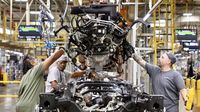In a significant shift aimed at easing the burden on American automakers, U.S. President Donald Trump signed two executive orders on April 29, 2025, that will relax tariffs on imported vehicles and auto parts. This move, described by Mexican President Claudia Sheinbaum as providing Mexico with "an additional comparative advantage," comes just over a month after the tariffs were initially announced.
The executive orders modify the 25% tariffs that were set to take effect on imported vehicles starting April 3, 2025, with a similar tariff on certain auto parts scheduled for May 3, 2025. During a rally in Warren, Michigan, marking his first 100 days in office this term, Trump stated, "I’ve just signed an Executive Order to give partial Tariff rebates to any company that assembles its cars right here in the USA." He emphasized that this change grants automakers "a little bit of a break" as they navigate the complexities of trade.
The justification for these tariffs, according to the U.S. government, is that imports pose a threat to national security. Trump remarked, "They took in parts from all over the world. I don’t want that. I want them to make their parts here. But I gave them a little bit of time. It’s called a little flexibility. We give them a little time before we slaughter them if they don’t do this." This statement underscores the administration's push for increased domestic production.
Under the new rules, the U.S. will offer an offset for a portion of the tariffs on automobile parts used in U.S.-assembled vehicles. This offset amounts to 3.75% of the Manufacturer’s Suggested Retail Price (MSRP) retroactively from April 3, 2025, until April 30, 2026. From May 1, 2026, to April 30, 2027, the offset will decrease to 2.5% of the MSRP. However, no offsets will apply after April 30, 2027, a timeline that many automakers and suppliers argue is insufficient for them to reorganize their manufacturing operations.
Notably, the executive orders maintain that U.S. content in vehicles assembled in Mexico will remain exempt from the 25% tariff, effectively reducing the duty on those vehicles. Sheinbaum acknowledged this exemption, stating, "With the document that was signed yesterday, it is recognized that the exemption is not just for the part made in the United States, but in the three [USMCA] countries." This highlights the importance of the United States-Mexico-Canada Agreement (USMCA) in shaping trade relations.
Furthermore, Trump’s executive order includes provisions to prevent the stacking of tariffs. This means that different tariffs imposed for various reasons will not apply cumulatively to the same product, particularly benefiting automakers who import vehicles and parts. As part of this adjustment, manufacturers will no longer face the 25% tariffs on steel and aluminum imports when bringing in vehicles and auto parts, easing the overall cost burden.
Despite these concessions, analysts have warned that Trump's policies could still lead to higher vehicle prices, potentially adding thousands of dollars to the cost of cars. The American Automotive Policy Council, which represents major companies like Stellantis, Ford, and GM, stated it would review the order to assess its impact on the auto supply chain. Trump’s actions are seen as a push for automakers to increase their domestic production, with the long-term goal of creating more jobs in the U.S.
In a related context, Secretary of Economy Marcelo Ebrard of Mexico described the similar treatment of auto parts between the U.S., Mexico, and Canada under the USMCA as advantageous for Mexico. Trump’s new executive order raises the Regional Content Value necessary for tariff exemption to 85%, establishing a framework that will benefit manufacturers who utilize components from all three countries.
Ebrard noted, "That and other contents of the measures that are being announced speak to us… We will continue to have a relative, advantageous situation with respect to the set of tariffs that are underway." This comment reflects optimism among Mexican officials regarding the implications of the new tariff structure.
In summary, Trump’s executive orders represent a strategic adjustment in U.S. trade policy, aiming to support American automakers while also recognizing the interconnected nature of the North American automotive supply chain. As this policy takes effect, the implications for vehicle pricing, production strategies, and international trade dynamics will continue to unfold, with both American and Mexican stakeholders closely monitoring the changes.
With Mexico's auto sector exports valued at $193.9 billion last year, accounting for 31.4% of the country's total export revenue, the stakes are high for both nations. The evolving landscape of tariffs and trade agreements will undoubtedly shape the future of the automotive industry in North America.





